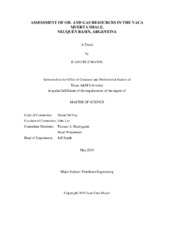| dc.description.abstract | According to the 2015 Energy Information Administration (EIA) global assessment (EIA 2015), Argentina ranks third among countries in shale-gas resources and fourth in shale-oil resources. The Vaca Muerta formation in the Neuquén basin holds most of these resources. After the first EIA assessment of these resources in 2011, there has been a huge increase in investment, given the interest of the Argentine government to recover the energy autonomy it lost in the 1990s. The rush to start production led to the drilling of vertical wells designed to take advantage of the thickness of the formation, of up to 500 m (1640 ft). The poor results of the vertical wells made some investors reconsider the potential of the Vaca Muerta formation. In 2014, YPF drilled the first horizontal wells in cooperation with Chevron. The good results of these horizontal wells attracted more operators to invest in Vaca Muerta, either independently or through joint ventures with YPF. Four years later, with more production data available, it is possible to re-evaluate the potential volumes of oil and gas that are technically recoverable. Accurate estimation of the resource size and future production, as well as the uncertainties associated with them, is critical for making development decision for these shale oil and gas resources. A probabilistic-decline-curve-analysis method was chosen to incorporate the publicly available data production data into play-wide study in a simple and fast way, as well as to quantify uncertainty. The Vaca Muerta formation was subdivided into sub-areas based on the fluid type. The most appropriate decline model was determined for each sub-area and coupled with MarkovChain-Monte-Carlo (MCMC) methodology to analyze and forecast production of existing wells to calculate reserves. The analyses of individual wells in each sub-area were used to iii create probabilistic type-decline curves. These curves were combined with the estimated acreage per well distributions and the remaining drillable areas per sub-area to estimate contingent and prospective resources. The difference between contingent and prospective resources was based on the distance from existing wells. As of January 2018, the total reserves (P90–P50–P10) for the Vaca Muerta shale in Argentina associated with existing wells are estimated to be 8.5–17.5–38.4 MMm^3 of oil and 9.5–27.2– 74.6 Bm^3 of gas. Estimated contingent resources are 8.8–50.6–181.1 MMm^3 of oil and 2.6– 16.4–51.5 Bm^3 of gas. Estimated prospective resources are 424–2,464–8,771 MMm^3 of oil and 211–1,279–3,483 Bm^3 of gas. Resources and reserves were combined to estimate the technically recoverable resources (TRR). The estimated TRR were 443–2533–8992 MMm^3 of oil and 223–1223–3609 Bm^3 of gas. The P10/P90 ratio of the oil TRR estimate, 21.27, is a more realistic estimate of the actual uncertainty compared to the 2.02 ratio of the only other probabilistic study by Gutierrez Schmidt et al. (2014). The other, deterministic, oil estimates of previous studies fall within the range of the estimates provided in this thesis. The gas estimates of this thesis are significantly lower than those in previous deterministic volumetric estimates, but slightly higher than the P10 estimate from YPF (2011). This is the first public estimate conducted using production data from existing wells. The results of this work should provide a more reliable assessment of the size and uncertainties of the resources in the Argentine Vaca Muerta shale than previous estimates obtained through volumetric methodologies and analogies. | en |


